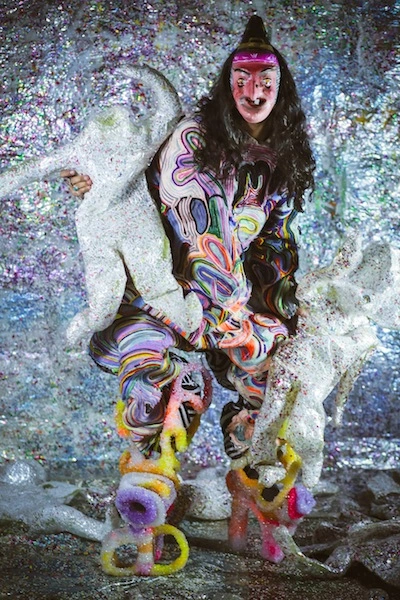
- Source: ArtNews
- Author: John Chiaverina
- Date: November 24, 2014
- Format: Online
The Shape of Opera to Come: ‘The Fool’ at Issue Project Room
On Tuesday, November 11, in Downtown Brooklyn, the stunning natural acoustics of Issue Project Room, which is located in a former Elks Lodge, reverberated with the premiere of Raúl De Nieves and Colin Self’s chamber opera, The Fool. A sold-out crowd gave a standing ovation to the nearly hour-long performance, the first stab at opera by two performers with serious alternative art and music pedigrees—Self as a solo artist and performer with the collective Chez Deep, and De Nieves as a multi-hyphenate artist who has collaborated with the likes of Ryan Trecartin and who fronts the excellent art-punk band HARIBO.

COURTESY ISSUE PROJECT ROOM
Scored in four acts for chorus—whose members wore white body suits that at one point in the show inflated in a manner that can only be described as “Wonka-esque”—and string ensemble, and at times accompanied by recorded electronic music, The Fool is decidedly contemporary while remaining steeped in the traditions of both opera and performance art.
The piece is a sort of circular birth/death transformation story centered around a mother, a child, old women, and a dog/fool (the old women played by Self and the dog/fool played by De Nieves) and was the result of over a year of work, its presentation timed with De Nieves’s current residency at Issue Project Room, whose 40-foot vaulted ceilings provided the perfect sonic stage for a work that presented the unamplified human voice in all of its glory.
The traditionally operatic histrionics of each brightly-costumed character anchored the production: at one point the child (played by Alexandra Drewchin) was dragged away from her mother, kicking and screaming, through a stunningly bedazzled door that opened and closed throughout the program to allow characters and chorus to enter and exit.
In an interview with ARTnews after the performance, Self and De Nieves explained that the narrative of “the fool” was born out of conversations and shared life experiences. “The fool kept appearing in our lives in such crazy ways,” Self said. “Weird things would happen.” He said that he came to the realization that both he and De Nieves were “the archetype of the fool, we’re living this reality. A character that’s sort of betwixt or in between—they are the void, they nix out systems of quantification or value.”
A fluid collaboration grew out of that shared realization. “I would be at my MIDI keyboard and we would take the text we had written together and I would start to sing things, or Raul would sing something,” explained Self.
De Nieves tossed ideas to Self, who would execute them with his musical knowledge. “I’d be like, ‘It should be scary!’” he explained, “and then Colin would be like,”—he mimicked a wild piano sound— “and it would be like, whoa! That’s scary enough!”
It was during this process that ideas for costume and stage design started to materialize. Although set design (the centerpiece of which is the aforementioned bedazzled door) can be attributed to De Nieves, both artists stress the collaborative nature of the project, giving deep amounts of respect to conductor Brian McCorckle. “We both don’t feel too strong about ownership,” Self said. “It’s more about the community.”
When applied to the creation of something as large-scale as an opera, Self and De Nieves’s background in the New York DIY art and music community seems to be just as important practically as it is aesthetically. “This a very do-it-yourself type of production,” De Nieves said. “We did this with a budget of like, zero, and how that’s possible is through the community that we helped build through our friendships with these people and our trust.”
Looking forward, Self is excited about opera’s potential as a container for multidisciplinary art. “The idea is that opera is something that we should start looking back into as a way to combine all these different ideas and media forms,” he said. “To me that’s what opera means now—bringing (together) all these minds that have something to say, and are extremely open to making it happen with each other.”

